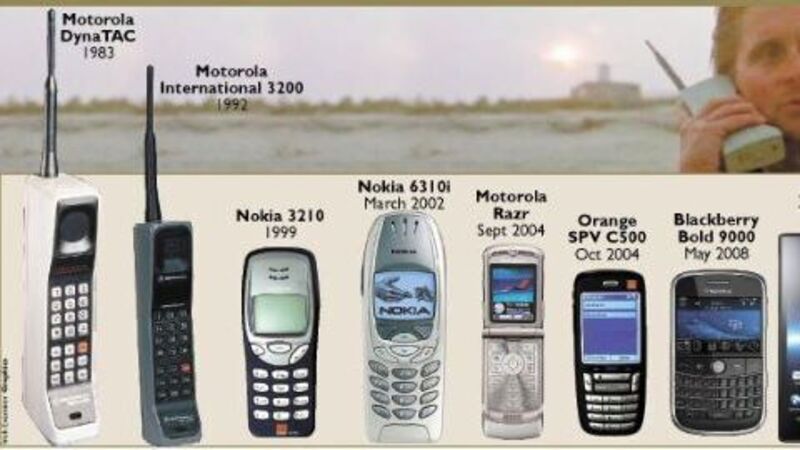How 40 years of mobile has changed us all

IT doesn’t seem like 40 years since the world was introduced to the first mobile phone.
It was April 1973 — the same year the Vietnam war ended, Pink Floyd released Dark Side of the Moon, Ireland joined the EEC, and Hugh Leonard’s Da was first staged — that the essential item which would command pride of place in every pocket and handbag on the planet was unveiled.
Martin Cooper, a vice president at Motorola Communications, took the prototype called a DynaTac for a lunchtime stroll around Manhattan. Weighing 1.3kg and equal in size to a standard brick, the phone enabled Cooper to call his rival at Bell Labs on April 3 to announce that Motorola had beaten them in the race to develop the world’s first mobile.
Cooper, now 83 and still involved in the communications business, recalled years later the reactions of passers-by on that fateful day. “As I walked down the street talking on the phone, sophisticated New Yorkers gaped at the sight of someone actually moving around while making a phone call,” he said. The second call he made was to a local radio station: “I crossed the street while talking to the radio reporter — probably one of the more dangerous things I have ever done in my life.” Little wonder he stopped traffic. This was an era long before the personal computer, digital cameras, or even the internet existed — all of the things, in fact, that today we take for granted in our Blackberrys, iPhones, and Samsungs.
Having a mobile phone was a status symbol across the world, and Ireland was no different. Regardless of how bulky the early models were, being able to afford the £1,000 price tag was a statement you had arrived. Quite apart from how the mobile changed the way we did business, it also liberated us to divulge details in public that would have been an utter no-no previously.
Socialites strolling down Grafton St cared not a whit who overheard when they bellowed: “I wouldn’t be seen dead at her party, make up some excuse.” Where before we had to strain to eavesdrop on a private conversation, it was now almost impossible to avoid them. Similarly, the adulterous goings-on of total strangers became fair game in public places such as cafes and hotel foyers as assignations were planned: “Can’t you tell her it’s an overnight trip, that all the companies are doing it,” could often be earwigged, followed by the details of what kind of lingerie would be displayed during that fictitious business trip. Where a previous generation of suspicious wives would have looked for lipstick on the collar of an errant spouse, it was now the monthly phone bill that caught them in the act as their frequent dials told the sordid tale. So enraged were thousands of French men by the discovery of their adulterous carry on, mobile companies were forced to replace the last four digits of numbers dialled with asterisks.
It wasn’t until the 1980s that phone design got more inventive, user-friendly, and well on the way to being a fashion statement. In 1987, the Oscar-winning film Wall Street did more for sales than a thousand ad campaigns when Michael Douglas, playing the ultimate alpha male, Gordon Gekko, bought and sold millions as he barked orders into his cool FY8850 mobile strolling on the beach. Representing the “greed is good” ethos that was then captivating Wall Street and the Square Mile, the association between wealth, power, and a good signal was forever linked. Such a global hit was the Wall Street phone that retro models are still for sale today on eBay — but now with all the modern bells and whistles added.
Mobiles have now become an integral plot device in movies going back to Jerry Maguire and up to James Bond in Skyfall. Even the hardened Dublin gangsters in Love/Hate kept them as close as their guns. Stephen King wrote a whole novel, Cell, devoted to them. In 1999, Barbie got in on the act — a sure sign the phone was now the height of fashion. Dressed in her ultra-cool pinstripe suit and stilettos, she now added a ‘fizz pink’ mobile to her bag, laptop, and coffee mug. When she said: “Going to work is fun!”, a million teenyboppers listened with rapt attention, tugging Daddy’s elbow.
Proving just how deeply the attachment to mobiles can become, a survey last year found that a third of Americans admitting they would be more willing to give up sex for a week than be without their mobile phone. Across the wide range of brands, iPhone users were more likely than their Android or BlackBerry counterparts to spend a week without creature comforts rather than be separated from their beloved smartphones. Sex was not the only thing they were willing to forego — 55% would be more willing to give up caffeine for a week rather than their mobile phone, 63% would deny themselves chocolate, and 70% would be willing to forego alcohol. Having ensconced itself in our lives to the extent that it is the last thing we see before sleep and the first upon waking, little wonder the humble mobile is now an extension of our personality.
Snobbery is everywhere, with Blackberry users claiming the tech high ground, while iPhone fans proudly point to their model’s superior ergonomics.
Even those who continue to use a 10-year-old Nokia 6310i, like Taoiseach Enda Kenny, get increased street cred for sticking with a classic. In fact, so attached is Enda to his mobile, he seemed quite unconcerned about fiddling publicly with his during a papal audience last year — a clear case of choosing digits over divinity, it seemed.
For all of the social change and efficiency they have brought us over the past four decades, it was the role mobile phones played in the 9/11 attacks on the World Trade Center that linger longest in the memory. While the world watched, as the fires swept upwards along the towers, condemning thousands to a horrific fate, it was the tapes of those last words between loved ones that still transfix us 12 years later. “I love you, you’re my best friend. I don’t know if I’m going to get out of it. You have to take care of everybody for me…”
These were Jim Gartenberg’s last words to his pregnant wife Jill from the 86th floor of the North Tower. Sept 11 was going to be his last day in his World Trade Center office — he had gone in to clear his desk before moving to another job. Trapped by raging fire and crumbling walls, Jill stayed on the phone with him until the towers fell. “Just to have his voice, it’s some last memories,” she said. “I was three months pregnant, and here I am now with this special gift that Jim left me with. Knowing that she’s a part of him and my other child is such a part of him — it makes me happy.” Rescue workers could hear the phones ringing while they dug for bodies.
Since Captain James Kirk first whipped out his “cordless communicator” in Star Trek in the 1960s, mobile phones have become one of the century’s biggest inventions. No longer just for talking, they are now an essential item in almost all we do.
Who wears a watch anymore? Nowadays, the biggest gift for a 10-year-old is no longer a watch, but their first mobile.
Take a picture of your boy’s first steps, and send it to six different locations around the world in two seconds flat.
Time was when we kept 50 phone numbers in our heads — now we keep a thousand in our pocket.
No more fussing about exchange rates in that dingy Egyptian bazaar. Just hit the currency converter.
No need to rely on the reception dude to wake you for that 5am flight. Just set your timer.
No more embarrassing grammar and syntax mistakes thanks to the spell-check feature
No excuses for missing Mother’s big day anymore.
If your partner is late, you can read a novel, write a blog, or play solitaire.
Track your Google or Apple shares, and buy a few extra while you’re still in bed.
Talk might be cheap, but text is free, depending on what package you are on.
Tell the world about your latest discovery, and get ready for a hundred responses.
An inbuilt stopwatch can measure your sprints.
No need for a list. Just take a photo of the inside of your fridge and refer to it when you’re walking down the supermarket aisles.










